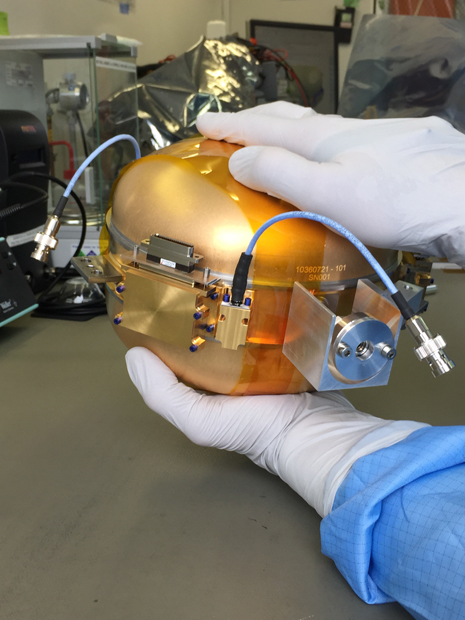Instrument glitch delays next NASA Mars mission
Tiny but persistent leaks in the vacuum housing of ultra-sensitive seismometers aboard NASA's Mars-bound InSight probe have forced the space agency to call off plans for a March launch and to suspend the mission, budgets permitting, until the next planetary launch window opens more than two years from now, officials said Tuesday.
InSight, which stands for Interior Exploration Using Seismic Investigations, Geodesy and Heat Transport, had been scheduled for launch atop an Atlas 5 rocket from Vandenberg Air Force Base, Calif., on March 4, the opening of 26-day window.
The solar-powered spacecraft was expected to descend to a rocket-powered touchdown on Mars on Sept. 28, kicking off a 728-day mission to study the planet's interior structure, evolution and history. The project has cost $525 million to date and is cost capped at $675 million.
InSight is built around two primary instruments: a sub-surface temperature probe supplied by DLR, the German space agency, and the seismometer package, designed by the French space agency, CNES, to measure tiny movements in the martian crust and deep interior.
The seismometers are housed in a flattened sphere about eight inches across that is designed to maintain a vacuum at the start of the mission as low as one billionth of the pressure of Earth's atmosphere. That enables the seismometers to measure movements as small as the width of an atom.
"The sphere, which contains the seismometers, has to be pumped out to an extraordinary level of vacuum to prevent any disturbances inside of the sphere so it ... can detect very small disturbances on Mars," said John Grunsfeld, NASA's director of space science operations. "And unfortunately, since last August we have been fighting a series of very small leaks, but leaks that are big enough that we wouldn't be able to accomplish our mission."
On Mars, the seismometers have to operate in extremely low temperatures "and it was during the cold-cycle testing just within the last few days that we have determined the sphere is still leaking," Grunsfeld said.
"We are close enough to launch that, unfortunately, we don't have enough time to identify the leak, fix it and recover and still make it to the launch pad in March," he said. Despite the science team's disappointment, he added, "it's much better that we have this discussion now rather than sending it to Mars and wishing we had the opportunity here on Earth to fix something."
Mars launch windows open every 26 months or so based on the relative positions of Earth and Mars in their orbits and the power of available rockets. Bypassing the March 2016 window will delay InSight until May 2018 at the earliest.
While disappointed, InSight principal investigator, Bruce Banerdt, said he agreed with the decision to suspend the mission.
"We completely concur in the decision to hold off on this launch until we can get this problem under control," he said. "I am, of course, a little disappointed that we're not going to be launching in March to get the science measurements that we're looking forward to to throw some light on the early processes of terrestrial planet formation and the structure of Mars.
"But I'm a very patient man, I've been working toward getting these kinds of measurements for the last 25 years, and so I sort of see this as a minor setback rather than a disaster. It's not a disaster, it's just a hiccup on our path to getting this kind of science."
The InSight spacecraft, built by Lockheed Martin, was shipped to Vandenberg on Dec. 16. It now will be shipped back to the manufacturing facility while engineers in Paris continue troubleshooting the vacuum bottle leak.
The question facing mission managers is not so much whether the seismometer package can be repaired. It's whether NASA can absorb the additional cost of repairs and the cost of a 26-month delay while staying within the cost cap.
Grunsfeld said it likely will take six weeks to two months to figure out what needs to be done, to assess the cost and to decide whether or not the mission can proceed.
InSight is similar in design to NASA's Phoenix lander, which touched down near the red planet's north polar region in 2007 to study the ice locked up in the red planet's frigid crust. Like Phoenix, InSight will remain stationary once on the surface, using cameras and its two state-of-the-art instruments to study the internal structure of Mars.
The Heat Flow and Physical Properties Package, provided by DLR, is designed to hammer a probe some 15 feet into the surface of Mars to measure how much heat is flowing from the interior and to shed light on how that has affected the planet's history.
The CNES-supplied Seismic Experiment for Interior Structure, or SEIS, instrument features three extraordinarily sensitive seismometers housed in a near vacuum.
Asked if InSight could be launched as is and still collect useful, if degraded, seismic data, Grunsfeld said flatly "at this leak rate, (the instrument) would not work at all."



